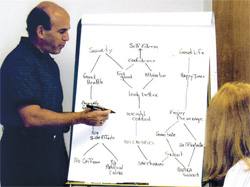Clients are well familiar with Discussion or Topic Guides. At BRG we use them to guide but not control the discussion. Much like a detective we are looking to solve the puzzle you have given us. We prepare a plan that lays out the discussion including suggested techniques. There is art and science to great moderation. The science is having the tools. The art is knowing when and how to use them. The art comes into knowing when to delve more deeply into a rich vein in the discussion or employing less traditional techniques. Here are a few of the techniques we may choose to use.
Projective Techniques
Projective Techniques allow researchers and decision-makers to delve beyond people’s surface cognitions or rational explanations for their attitudes or behavior using a broad range of tools and techniques.
- Personification: requires respondents to convert a product, brand, or organization into a person with a full range of personality, psychographic, demographic, and behavioral dimensions. The results can be used as input in all types of strategic planning where a thorough understanding of image dimensions and drivers are important.
- Fantasy Excursions: projects respondents into fantasy arenas to help them explore their images, wants, and needs concerning products and services. This technique helps participants move beyond the trite and timeworn explanations for their thoughts and feelings.
- Associations: Respondents are presented with a stimulus (word association or brand or other product/service personification) and they respond by indicating the first word, image, or thought elicited by the stimulus.
- Construction: Respondents are asked to construct a story or picture from a stimulus concept.
- Completion: Respondents are given an incomplete sentence, story, argument, or conversation and asked to finish it.
Laddering
A probing technique, used in one-on-ones and focus groups, designed to delve into the real reasons for participants’ attitudes and behavior toward the topic. It is generally considered to be an intensive technique. The moderator seeks the reason behind each answer until he or she arrives at a basic human need such as ego or status. Often used to explore how consumers translate product attributes into personal values and underlying psychological motivations. Used extensively for customer segmentation, brand and product image assessment, and development of advertising or market strategies.


 QRCA is a not-for-profit association of consultants involved in the design and implementation of qualitative research — focus groups, in-depth interviews, in-context and observational research, and more.
QRCA is a not-for-profit association of consultants involved in the design and implementation of qualitative research — focus groups, in-depth interviews, in-context and observational research, and more.